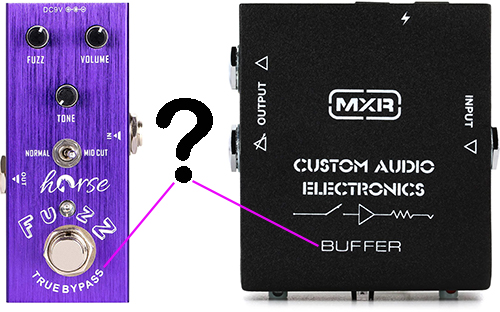Although no one wants to have tone suck coming from their pedalboard, no one seems to know how to prevent it. In my opinion, that’s because people don’t really understand the different types of bypass.
It all depends on your specific situation, so what works well in one scenario may not perform well in another. Don’t worry, though. Once you know the ways pedal bypass can affect your sound, you’ll have a lot better idea of what to do.
So, let’s get going. What’s the difference between a True Bypass pedal and a Buffered Bypass pedal?
When a pedal is switched off, a true bypass pedal has the input directly connected to the output, whereas a buffered bypass pedal will have an internal buffer circuit that stays in the signal path.
Now, that’s just an intro to the idea. There are other types of bypasses to know about than just those two. Let’s look at the different kinds of pedal bypasses and how they impact your tone.
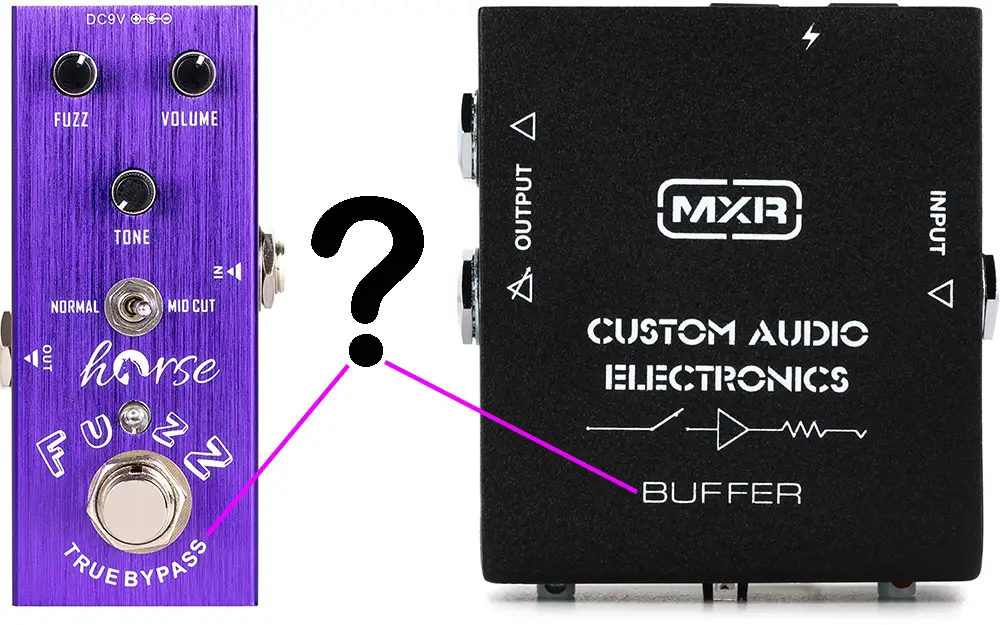
Types of Pedal Bypasses
True bypass (sometimes called “hard bypass” )
Connecting the input and output jacks directly bypasses the pedal’s electronics and connects them to one another, rather than through the effect. The input impedance of the effect does not influence the sound when it is bypassed.
Standard bypass
Standard bypassing causes the output jack to be disconnected from the effect’s output and connected to the input. However, the input impedance is still an issue because the effect’s electronics are still linked to your guitar’s signal.
Internal bypass
The output of an effect is effectively bypassed, using electronic bypassing occurring inside the effect’s circuitry.
Reverb or chorus is a good example. Turning off the pedal might cause the wet/dry mix control to be bypassed and go from a mixed signal to an all-dry signal. There may also be additional internal electronic switching.
The input impedance of the pedal will still have an impact on your signal.
Buffered pedal
Buffering describes the input circuitry in the pedal rather than how a signal is bypassed.
A buffered pedal means that your signal goes through an op-amp inside the pedal.
A buffered bypass pedal means that your signal goes through an op-amp even when the pedal’s effect is disengaged.
Depending on the pedal, the buffer circuitry may or may not remain in the signal path when bypassing the effect. The type of bypass is usually indicated in the specs.
BOSS, Ibanez, and other pedals buffer the signal even when the effect is disabled. Other pedals use True Bypass in their marketing as one of their features.
Buffered Bypass Pedals
Most guitar players don’t realize that the pedals they have on their pedalboard are either buffered or true bypass. There is a difference between these two types of pedals, and it’s important to know what that difference is in order to get the most out of your setup.
The truth about buffers is that buffers can be beneficial when using long cable runs or feeding other true bypass pedals. Let’s take some time to learn about buffered bypass pedals.
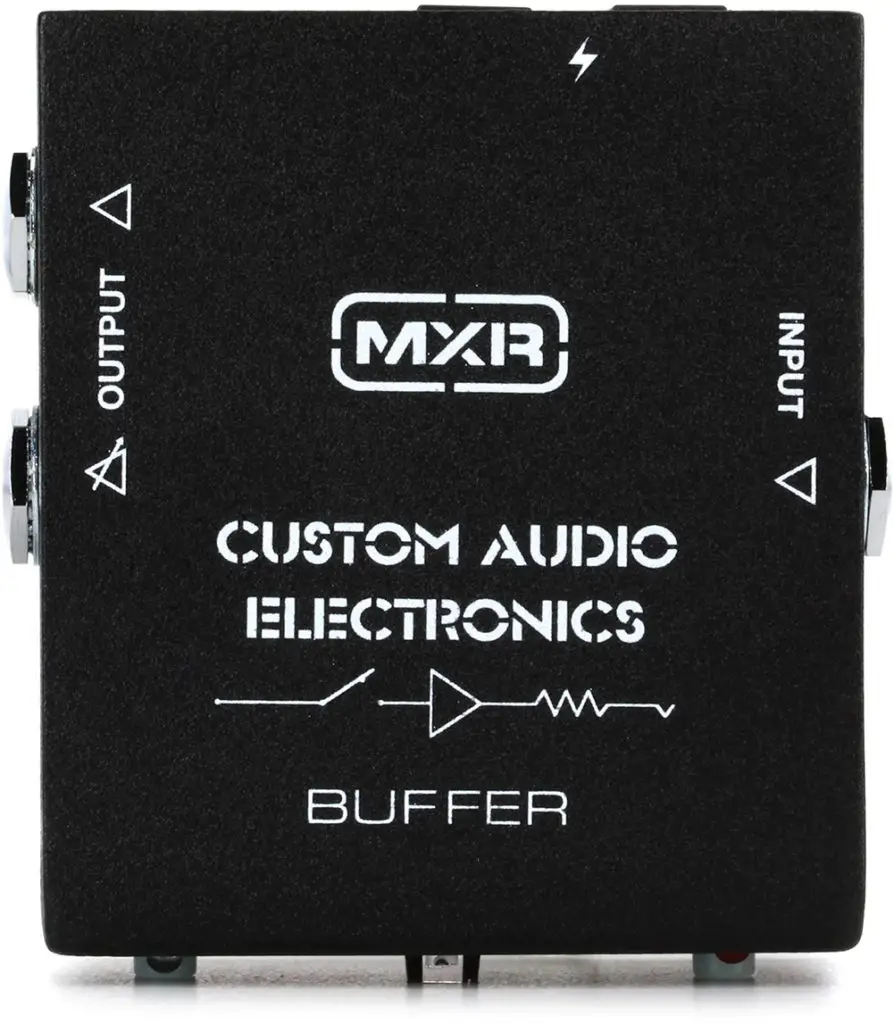
What is a buffered pedal?
A buffered pedal uses an internal buffer amplifier to take a high impedance input to drive a low impedance output. Buffered pedals can drive long cable runs or feed other true bypass pedals with much less high-frequency signal loss.
A buffer also helps eliminate popping due to any DC offset when switching the pedal on and off. Popping is a common problem in true bypass pedals because the switch literally switches between two different circuits, which may be at different DV levels.
The name “buffered” comes from the type of amplifier circuit that I mentioned; a buffer amplifier. This type of circuit can also be referred to as a unity-gain amplifier, a voltage follower, or an isolation amplifier.
Buffer amps are a common circuit in electronics; hence the many names it goes by. Here is what a buffer amplifier circuit looks like:
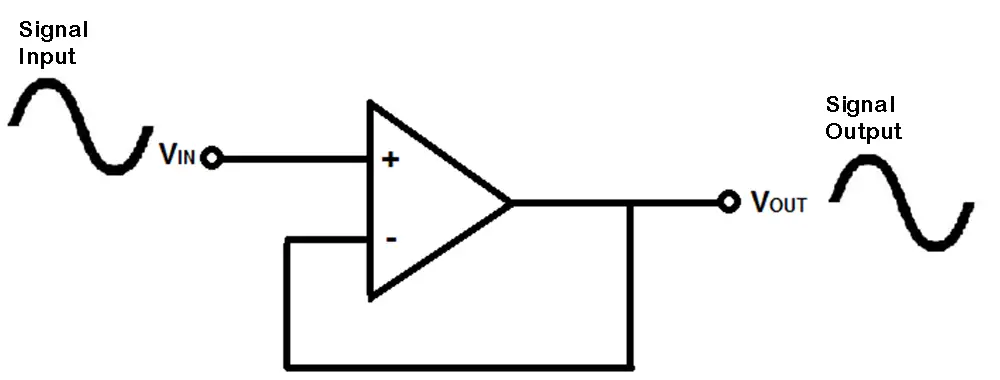
This type of op-amp circuit has a voltage gain of 1, which is why it is called a unity-gain amplifier.
This means that the op-amp does not provide any amplification or attenuation to your signal as it flows through. The output signal will appear the same as the input signal but with a low impedance.
What is a buffered bypass pedal?
A buffered bypass pedal will buffer the input signal even when the pedal’s effect is not engaged. A buffer converts the high impedance input signal into a low impedance output.
Are buffered pedals bad?
Buffered pedals are not good or bad. A buffered pedal is a tool that should be used in certain situations.
Buffered pedals can be beneficial in that the buffer will compensate for any signal loss in long cable runs or as the result of feeding true bypass pedals. Buffered pedals can also be designed to have absolutely silent switching.
Buffered pedals before treble boosting pedals, such as a tube screamer or beano boost, may give the undesired effect of too much treble.
How do I know if my pedals are buffered?
It is possible to determine if you have a buffered bypass pedal by removing all power sources, plug or battery, and seeing if the signal passes through when the pedal is disengaged.
This test will be sufficient to determine if a buffer is active when the pedal is disengaged.
However, if the signal passes through, it will not tell you if the pedal is a true bypass pedal or a standard bypass pedal.
To determine if a pedal is a true bypass pedal, you will need to either look at the schematics or open up the pedal and exam if the input is directly connected to the output when the switch is disengaged.
The input circuitry always loads down your guitar, even when bypassed, when using standard bypass or internal bypass. If the effect feeds another effects pedal with standard bypass, the second effect will add more loading when bypassed.
True Bypass Pedals
It seems like ever since the introduction of effects pedals, people have been debating the benefits and drawbacks of buffered bypass.
Some guitarists find that buffered bypass can cause distortion or signal loss when it is installed in a pedalboard setup. In order to alleviate these problems, many guitarists are turning to true-bypass pedals as an alternative solution.
The goal is that none of the pedal’s sound, other than the jack connection and wire, enters the signal path unless it is engaged.
Let’s take a look at true bypass pedals to really gain an understanding.
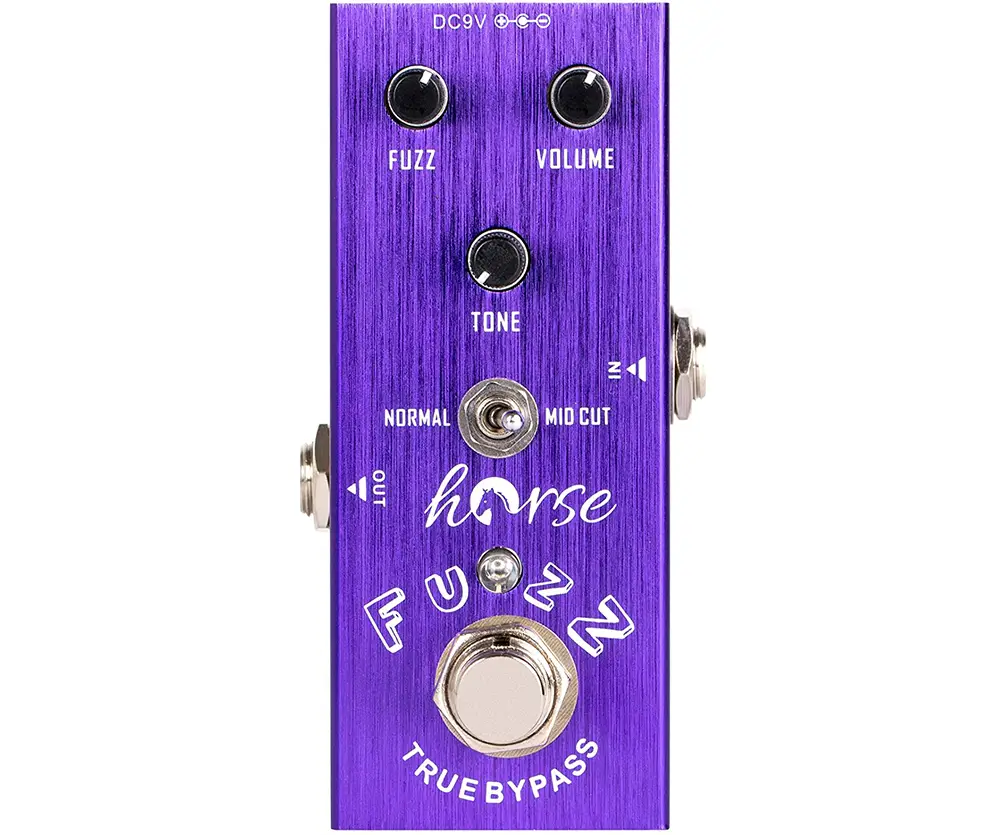
What is a true bypass pedal?
When the pedal is disengaged, a true bypass pedal sends the input signal directly to the output without any buffering or additional loading of the input signal. The signal is sent straight through the pedal without being altered in any way.
It’s as if the cable is going directly through the pedal, and the pedal’s effects aren’t even there.
True-bypass (sometimes referred to as “hardwired”) is what happens when the pedals are switched off, or disengaged. The effect circuit is immediately disconnected from the signal path when you step on the pedal to disengage it.
If this signal is not flowing through a built-in buffer amp, one would think that the signal would remain pure and unaffected.
This is only true when using short cables, however. Outside of practicing, our cables are often 18 feet or longer, and there are at least two of these (along with some short patch cables).
A buffer amplifier converts a high-impedance signal to a low-impedance in order to pass through long cables without impairing the signal. This is one of the properties of an op-amp.
Keep in mind that there will be a loss of high frequencies even with a long cable leading straight into the amp.
I don’t want to make this article too technical, but the cable has capacitance and resistance, and these are two factors that are used in a low-pass filter.
The longer the cable, the more capacitance it has. When the capacitance increases, the result is that the cut-off frequency is lowered.
The cut-off frequency means that nothing above that frequency passes through. So the lower the cut-off frequency, the less high-frequency or treble sound you will be able to hear.
If you are interested in learning more, or learn better from listening, here is a video that discusses the topic in-depth.
Do I need a true bypass pedal?
In a true bypass pedal, your signal passes through without being boosted, enhanced, or loaded down. True bypass pedals are great options if you don’t have that many pedals and are running a short cable length, less than 20 feet in total length. That includes from the guitar to the pedals and from the pedals to the amp.
There is no need to have a true bypass pedal, but a true bypass pedal with a short cable run will keep your tone true and not altered or colored.
True bypass pedals are a type of pedal that, when disengaged, sends the input signal directly to the output without any buffering or additional loading of the input signal. True bypass is as if the cable is going straight through the pedal, and its effects aren’t even there. The objective is that none of the pedal’s sound – other than jack connection and wire – is in the signal path unless it’s on.
With true bypass, your signal passes directly through, without these pedals doing anything to boost, enhance, or load down your tone. If you’re a player who only uses a couple of pedals and you’re using a relatively short cable (less than 18 feet), then true bypass might be for you! There’s no need for this type of pedal to have a buffer amp, but if it does have a short cable run, it’ll keep your tone true and unaltered.
How many true bypass pedals are too many?
In general, having 6 true bypass pedals without a buffered pedal in front is too many, and you will have a noticeable loss in your high-frequencies.
Even with a short run between the guitar, the pedals, and the amp, multiple true bypass pedals will result in signal degradation. The length of wire between all the parts starts to add up, which means the capacitance adds up, resulting in that high-frequency roll-off.
Resources for fixing True Bypass popping
https://www.sweetwater.com/insync/true-bypass-pedal-pops/
http://www.muzique.com/lab/pop.htm
What does bypass mean with a tuner?
Bypass is a term used to reference the state of a pedal when the effect is not engaged. You are bypassing the effect.
A tuner is in bypass mode when the tuner is not engaged or enabled. In effect, the tuner is turned off. The signal going into the tuner bypasses the tuning circuitry and goes to the output.
How do you use true bypass pedals?
True-bypass pedals can be used without a buffer pedal if only a few pedals (less than 6) or used and you have a short cable run. A buffered pedal should be used first if you have a long cable run or have many (6 or more) pedals before any true-bypass pedals.
Adding a buffer will keep your high-frequencies from disappearing from the guitar to the amplifier in a long cable run.
Pros And Cons Of True Bypass
As with anything, there are pros and cons to true bypass pedals. Let’s begin with a quick table to list the pros and cons before digging into each advantage and disadvantage in detail:
| Pros Of True Bypass | Cons Of True Bypass |
|---|---|
| When turned off, it provides a straight line from the guitar to the amplifier. | Popping is likely to occur when the pedal is turned on and off. |
| No change in tone (when turned off) due to buffer circuitry. | Adds to signal degradation, resulting in high-frequency roll off. |
| Does not require power. The pedal can be unplugged. | In time-based effects, it may result in abrupt halts (no effect tail) of the action when the pedal is turned off. (Example: delay and reverb.) |
| They’re usually more expensive. |
True Bypass Vs. Buffered Bypass
The most significant differences have been covered already. Still, I thought it might be useful to create a table showing the major distinctions between true bypass and buffered bypass pedals:
| True Bypass | Buffered Bypass |
|---|---|
| When bypassed, signal goes from input to output without passing through any additional circuitry. | Signal travels through a buffer amplifier when bypassed |
| No gain or signal alteration when bypassed (still has some impedance or capacitance due to the wires) | Buffer amplifier will have a low impedance at all times. |
| Does not actively alter tone quality when bypassed | Does actively impact tone quality when bypassed |
| Adds additional length to the overall cable causing more signal loss due to longer cable runs. | The buffer amplifier helps maintain signal integrity by driving a low impedance output, allowing for greater cable runs. |
| Cause pops when both disengaged and engaged | Does not cause pops when switched on and off |
| Effects immediately stop when disengaged | Allows effects to fade out when disengaged |
| More expensive for comparable features | Less expensive for comparable features |
Conclusion
True bypass pedals are pedals that, when disengaged, send the input signal directly to the output without any buffering or additional loading of the input signal. True bypass is as if the cable is going directly through the pedal, and its effects aren’t even there. Buffered pedals have a buffer amp built-in, which converts a high-impedance signal to a low impedance signal, preventing the high-frequency roll-off that can occur when using multiple pedals.
In general, having 6 true bypass pedals without a buffered pedal in front is too many, and you will have a noticeable loss in your high-frequencies. However, if you use a buffer pedal before all of your true bypass pedals, this will keep your high frequencies from fading in a long cable run.

